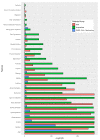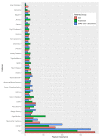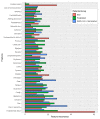Adverse Effects of COVID-19 Vaccination: Machine Learning and Statistical Approach to Identify and Classify Incidences of Morbidity and Postvaccination Reactogenicity
- PMID: 36611491
- PMCID: PMC9819062
- DOI: 10.3390/healthcare11010031
Adverse Effects of COVID-19 Vaccination: Machine Learning and Statistical Approach to Identify and Classify Incidences of Morbidity and Postvaccination Reactogenicity
Abstract
Good vaccine safety and reliability are essential for successfully countering infectious disease spread. A small but significant number of adverse reactions to COVID-19 vaccines have been reported. Here, we aim to identify possible common factors in such adverse reactions to enable strategies that reduce the incidence of such reactions by using patient data to classify and characterise those at risk. We examined patient medical histories and data documenting postvaccination effects and outcomes. The data analyses were conducted using a range of statistical approaches followed by a series of machine learning classification algorithms. In most cases, a group of similar features was significantly associated with poor patient reactions. These included patient prior illnesses, admission to hospitals and SARS-CoV-2 reinfection. The analyses indicated that patient age, gender, taking other medications, type-2 diabetes, hypertension, allergic history and heart disease are the most significant pre-existing factors associated with the risk of poor outcome. In addition, long duration of hospital treatments, dyspnoea, various kinds of pain, headache, cough, asthenia, and physical disability were the most significant clinical predictors. The machine learning classifiers that are trained with medical history were also able to predict patients with complication-free vaccination and have an accuracy score above 90%. Our study identifies profiles of individuals that may need extra monitoring and care (e.g., vaccination at a location with access to comprehensive clinical support) to reduce negative outcomes through classification approaches.
Keywords: COVID-19; adverse reactions; comorbidities; machine learning; statistical analysis; symptoms; vaccination.
Conflict of interest statement
The authors declare no competing interest.
Figures








References
-
- Aouissi H.A., Kechebar M.S.A., Ababsa M., Roufayel R., Neji B., Petrisor A.-I., Hamimes A., Epelboin L., Ohmagari N. The importance of behavioral and native factors on covid-19 infection and severity: Insights from a preliminary cross-sectional study. Healthcare. 2022;10:1341. doi: 10.3390/healthcare10071341. - DOI - PMC - PubMed
-
- Coronavirus Cases: Worldometer. [(accessed on 7 December 2022)]. Available online: https://www.worldometers.info/coronavirus/
LinkOut - more resources
Full Text Sources
Miscellaneous

